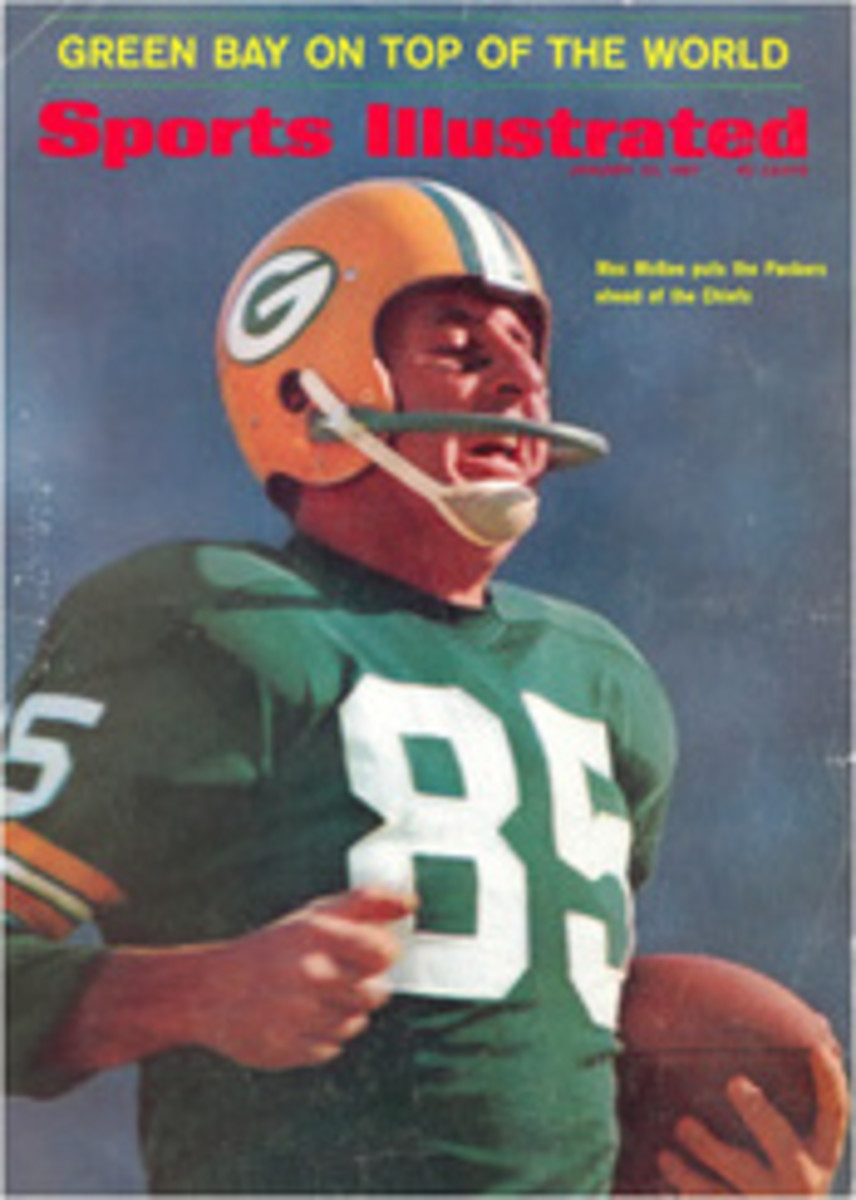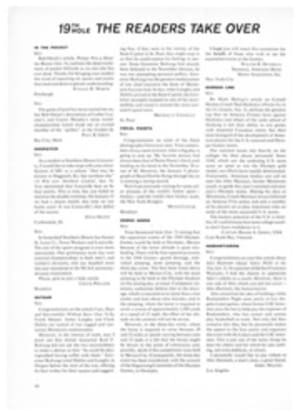
NO TRANQUILIZER LIKE VICTORY
Once upon a time the opening week of the pro golf tour at Los Angeles was one of the dependable way points of the year—like Thanksgiving or a Zsa Zsa Gabor wedding. There was the flavor of a family reunion as the pros regathered after a substantial rest, and the L.A. Open was the best possible place to look at the rookies and spot trends for the season ahead. All that was once upon a time, however.
Last week the 1967 pro tour started in a far different way, with nothing familiar except the note that the total purse money for the year was once again a record—$4,500,000, up half a million from 1966 and up $3.5 million from 10 years ago. The scene was the San Diego Open, an event that in the past has occupied the second week on the PGA schedule and attracted a field about on a par with that of a Suffolk Downs claiming race. The new season opener turned out to be only half a reunion, since such substantial members of the family as Jack Nicklaus and Arnold Palmer were not there, and it did not mark any significant return from vacation, since the pro tour is now a 12-month matter. Nor was it any place to look for rookies. But the fact that it wasn't was what provided the excitement, for men who have long since proved they can play the game took the first slice of golf's big melon. Finishing on top was once-terrible-tempered Bob Goalby, 35, who beat Gay Brewer, 34, by a stroke with a 15-under-par score of 269. In the forefront of the struggle on the Stardust Country Club course was a slightly mellowed Tommy Bolt (48), PGA Champion Al Geiberger (29), Bill Casper (35) and Doug Sanders (33). A few of the relatively young or less seasoned, such as Frank Beard, Dave Hill, Pete Brown and Randy Glover, were there, too, but they, after all, have been on the pro tour for several years at least. One looked in vain for a smashing newcomer, an incipient Snead who would soon be appearing on everybody's TV screen.
More or less present were some of the latest additions to the pro tour, 17 young men who had won their player's cards at the PGA school for neophytes last fall. But only 10 of the 17 managed to qualify among the 146 starters, only four of these survived the 36-hole cut to 77 players and none finished higher than 42nd. No signs or portents there.
Stardust is the kind of golf course that permits scoring that is subpar and seemingly superhuman. There were 56 rounds under par on the opening day (roughly one in three), 47 on the second day and 45 on the third, after the field had been cut to 77. During that round, four players came in with 66s—Steve Spray, Terry Dill, Hugh Royer and Tommy Aaron—and another six had 67s. At that point, Goalby, who had built a comfortable five-stroke lead, was 13 under par with three fine rounds of 68-64-68.
One had to look back nearly five years to the 1962 season to find a similar run of solid golf by Goalby, who had failed to win a tournament since. Most people blamed his decline on his temperament. He is a seether, one of the worst on the tour. The intensity of his heat rivals Tommy Bolt's, even though his public flames do not build as high. Instead of throwing clubs, he finds something to blame, such as the time he missed a short putt and went stomping about the green looking down at his feet, muttering, "Oh, damn these white shoes; damn these white shoes." Now, Goalby always wears white shoes, so...?
Goalby, while conceding his flammability, had another explanation for his tour troubles. "I started too fast," he said in the middle of last week's victory. "When I was winning all those tournaments, I didn't really understand what I was doing out on the golf course. Then when I started downhill I didn't know how to make the proper corrections." He has always been capable of spurts of remarkable golf—he once made eight straight birdies in the St. Petersburg Open—but his game was depressingly erratic.
The turning point in his career, he feels, came when Johnny Revolta took him in hand. "Johnny told me some things I hadn't realized before, and I started working with him," Goalby says. "We took my game apart and put it back together again. Now when I make a bad shot, I know how to correct it. The change began to show last May, and I've won about $2,350 a week since then. I can keep my temper under better control, too, but it's a lot easier to stay calm when you're scoring well." Sam Snead, he added, had helped him learn to keep himself in check.
Another glorious temper that seemed at least temporarily under wraps at San Diego was Bolt's, the man who once said, "Listen to that old bird up that tree. Sounds just like a rattlesnake, don't he?" Finding himself in a tie for third place at the halfway point, Tommy settled into a chair with a glass of Scotch and discussed himself with remarkable equanimity. He allowed as how he scarcely ever throws a club anymore because of an automatic $100 fine levied by the PGA. "I just eliminate them now," he said. "After all, you should be allowed to go over into the woods and eliminate a whole set of clubs if you don't like them. But you can't throw them. A lot of the kids they have around these days don't even know how to throw a club right. They throw it backward, and then they have to go all the way back to pick it up. When I threw a club, I always threw it ahead of me. That way I didn't have to walk any extra distance to get it."
Functioning on a more serene but hardly successful note at San Diego was Bill Casper, the hometown boy and defending champion who was the leading official money-winner last year. In front of his neighbors he could not get his game untracked until the final two days, when a 68-66 pulled him into a tie for sixth. Yet he was in a splendid frame of mind, for within the past few weeks a couple of climactic moments had occurred in his life. On Christmas Day he was ordained an elder in The Church of Jesus Christ of Latter-day Saints, and just over a week later he and his wife Shirley were remarried in the Mormon Temple at Salt Lake City.
Casper has found enormous personal comfort in Mormonism and thinks that it will prolong his career considerably. "The way I feel now," he says, "I could go on playing until I am 45 or more." For the present, his plans call for about the same number of tournaments this year as last—29, including one in the Philippines, one in Australia and two in Britain. During the foreign excursions he hopes to conduct "firesides" for the Church and do what he can to improve the American image, which he feels is "not too good."
Although San Diego turned out to be a pleasant enough event and a perfectly satisfactory start for the new season, the question still remains: Why this break with the traditional opening at the 40-year-old Los Angeles tournament? It solved no travel difficulties, for the players still have to make the 500-mile jump to Pebble Beach for this week's Crosby Pro-Am and then 400 miles back to the L.A. Open, now third on the schedule. As with most of the PGA's problems, there was no simple answer. There was a vague feeling that the new schedule would provide San Diego with a better field, since many of the richer players used to skip it and go directly to Pebble Beach from Los Angeles to prepare for the Crosby. Then there was television. The PGA wanted to have a TV package of three consecutive tournaments that would display the best players—Crosby, L.A. and the Bob Hope Desert Classic in Palm Springs. When the new arrangement was proposed to the L.A. Open officials last year, they seemed happy with it. However, their second thoughts have been distinctly sour ones, for they now realize a lot of prestige has been lost by not being the tour's first event.
Such vicissitudes notwithstanding, the PGA is off to another year of unprecedented prosperity, with much of the increase in prize money coming from television, which will broadcast 16 of the tour events, as well as the Masters, the USGA Open and other special tournaments which make their own TV arrangements. With so much money around, a man can finish in 53rd place on the list of winners and still earn more than $20,000—as Paul Bondeson did last year.
There is even enough money to make the new Bob Goalby smile upon the world around him, though the smile had a slightly frightened look to it for a few moments on Sunday. Through no fault of his own, and in spite of the five-stroke lead with which he started the day, Goalby found himself standing on the 15th tee in a tie with Brewer, who had just turned in a wonderful 64. A birdie and a bogey later, Goalby was still tied, but he refused to let Brewer's score upset him. He birdied 17 with a fine 10-foot putt that just fell in on the last turn, and then saved his win and the $13,200 first prize by getting down in two from a bunker at the 18th. Whatever it was Sam Snead told him, it was worth remembering.
PHOTO
As Caddie Leroy Gibson puts the flagstick back in the cup, a happy Goalby acknowledges applause for his first winning performance in four years.

